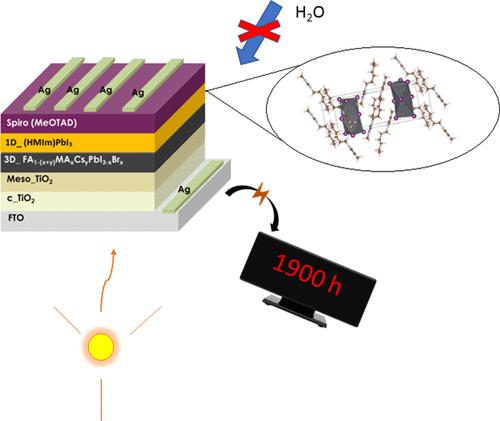当前位置:
X-MOL 学术
›
ACS Appl. Electron. Mater.
›
论文详情
Our official English website, www.x-mol.net, welcomes your feedback! (Note: you will need to create a separate account there.)
3D/1D Architecture Using a 1-Hexyl-3-methylimidazolium Lead Triiodide Interlayer for Robust and Highly Performing Perovskite Solar Cells
ACS Applied Electronic Materials ( IF 4.3 ) Pub Date : 2023-04-14 , DOI: 10.1021/acsaelm.2c01783 Eleftherios Christopoulos 1, 2, 3 , Mohamed M. Elsenety 4 , Andreas Kaltzoglou 3 , Constantinos C. Stoumpos 5 , Mattia Gaboardi 6 , Jasper R. Plaisier 6 , Polychronis Tsipas 1 , Elias Stathatos 7 , Evangelos G. Vitoratos 2 , Athanasios Dimoulas 1 , Polycarpos Falaras 1
ACS Applied Electronic Materials ( IF 4.3 ) Pub Date : 2023-04-14 , DOI: 10.1021/acsaelm.2c01783 Eleftherios Christopoulos 1, 2, 3 , Mohamed M. Elsenety 4 , Andreas Kaltzoglou 3 , Constantinos C. Stoumpos 5 , Mattia Gaboardi 6 , Jasper R. Plaisier 6 , Polychronis Tsipas 1 , Elias Stathatos 7 , Evangelos G. Vitoratos 2 , Athanasios Dimoulas 1 , Polycarpos Falaras 1
Affiliation

|
The simultaneous improvement in the performance and stability of the perovskite solar cells (PSCs) remains a key challenge toward their commercialization. Herein, we explore the ionic liquid 1-hexyl-3-methylimidazolium iodide (HMImI) for the synthesis of a lead halide derivative, namely, (HMIm)PbI3. According to single-crystal X-ray analysis, (HMIm)PbI3 forms 1D chains of face-sharing [PbI6]4– octahedra and behaves as a semiconductor with a band gap of 2.85 eV. This compound, when deposited on top of the main 3D perovskite (Cs/FA/MA)PbI3–xBrx, passivates the surface of the absorber by lowering the density of the trap states, thus enhancing the radiative recombination and the open circuit voltage. In addition, the hydrophobic character of the alkyl chain of the imidazolium cation prohibits the penetration of the humidity and at the same time prevents ion migration from and toward the main perovskite absorber. Furthermore, the PSCs based on this 3D/1D solar cell architecture achieved a power conversion efficiency (PCE) of almost 20% and retained practically 80% of their initial efficiency after 1700 h of storage under dark and ambient conditions, outperforming the corresponding 3D reference device. This is attributed to the high quality of the perovskite layer, as confirmed by grazing-incidence wide-angle X-ray scattering, scanning electron microscopy, atomic force microscopy, and contact angle measurements. The obtained results clearly indicate that the dimensionality engineering approach involving ionic liquids with the appropriate choice of the organic cation is a very promising strategy for improving the efficiency and stability of the perovskite solar cells.
中文翻译:

使用 1-Hexyl-3-methylimidazolium 三碘化铅中间层的 3D/1D 架构用于坚固且高性能的钙钛矿太阳能电池
同时提高钙钛矿太阳能电池(PSC)的性能和稳定性仍然是其商业化的关键挑战。在此,我们探索了离子液体 1-hexyl-3-methylimidazolium iodide (HMImI) 用于合成卤化铅衍生物,即 (HMIm)PbI 3。根据单晶 X 射线分析,(HMIm)PbI 3形成一维共面链 [PbI 6 ] 4–八面体,表现为带隙为 2.85 eV 的半导体。该化合物沉积在主要 3D 钙钛矿 (Cs/FA/MA)PbI 3– x Br x顶部时,通过降低陷阱态的密度来钝化吸收体的表面,从而增强辐射复合和开路电压。此外,咪唑阳离子烷基链的疏水特性阻止了湿气的渗透,同时防止了离子从主要的钙钛矿吸收剂迁移。此外,基于这种 3D/1D 太阳能电池架构的 PSC 实现了近 20% 的功率转换效率 (PCE),在黑暗和环境条件下存储 1700 小时后几乎保持了其初始效率的 80%,优于相应的 3D 参考设备。这归因于钙钛矿层的高质量,正如掠入射广角 X 射线散射、扫描电子显微镜、原子力显微镜所证实的那样,和接触角测量。The obtained results clearly indicate that the dimensionality engineering approach involving ionic liquids with the appropriate choice of the organic cation is a very promising strategy for improving the efficiency and stability of the perovskite solar cells.
更新日期:2023-04-14
中文翻译:

使用 1-Hexyl-3-methylimidazolium 三碘化铅中间层的 3D/1D 架构用于坚固且高性能的钙钛矿太阳能电池
同时提高钙钛矿太阳能电池(PSC)的性能和稳定性仍然是其商业化的关键挑战。在此,我们探索了离子液体 1-hexyl-3-methylimidazolium iodide (HMImI) 用于合成卤化铅衍生物,即 (HMIm)PbI 3。根据单晶 X 射线分析,(HMIm)PbI 3形成一维共面链 [PbI 6 ] 4–八面体,表现为带隙为 2.85 eV 的半导体。该化合物沉积在主要 3D 钙钛矿 (Cs/FA/MA)PbI 3– x Br x顶部时,通过降低陷阱态的密度来钝化吸收体的表面,从而增强辐射复合和开路电压。此外,咪唑阳离子烷基链的疏水特性阻止了湿气的渗透,同时防止了离子从主要的钙钛矿吸收剂迁移。此外,基于这种 3D/1D 太阳能电池架构的 PSC 实现了近 20% 的功率转换效率 (PCE),在黑暗和环境条件下存储 1700 小时后几乎保持了其初始效率的 80%,优于相应的 3D 参考设备。这归因于钙钛矿层的高质量,正如掠入射广角 X 射线散射、扫描电子显微镜、原子力显微镜所证实的那样,和接触角测量。The obtained results clearly indicate that the dimensionality engineering approach involving ionic liquids with the appropriate choice of the organic cation is a very promising strategy for improving the efficiency and stability of the perovskite solar cells.








































 京公网安备 11010802027423号
京公网安备 11010802027423号